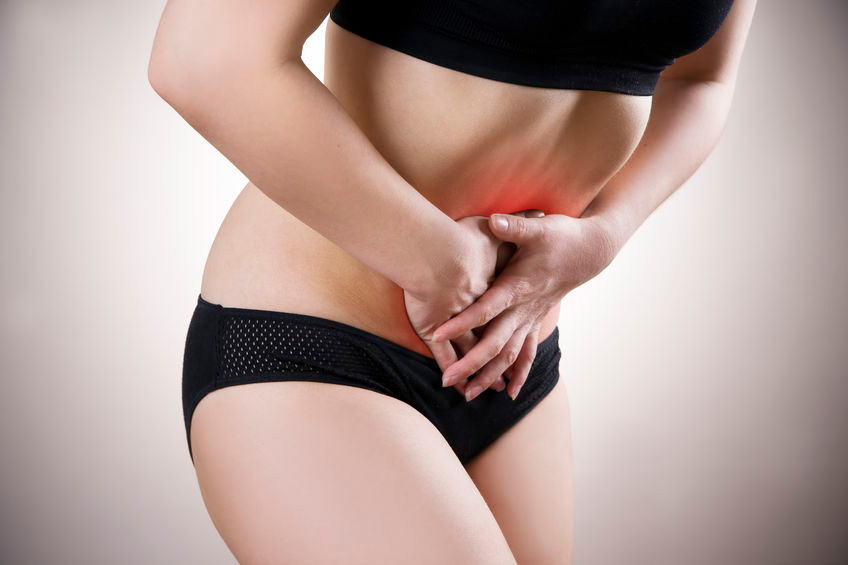In this article we take a look at the traditional symptoms associated with endometriosis, how it can develop, risk factors and the conventional approach to treatment. Following on from that we then looks at nutrition and lifestyle considerations, potential use of supplementation and finish with a summary of your key considerations.
Introduction to Endometriosis
What is endometriosis?
Endometriosis is a condition in which endometrial tissue develops outside the womb, most commonly around the ovaries, fallopian tubes, lining of the abdomen and on the bowel or bladder. It is understood to affect approximately 1.5 million women in the UK and most commonly occurs between the ages of 24 – 40 years. (1)
Typical symptoms of Endometriosis
Just like the cells in the lining of the womb, endometrial tissue found in other areas of the body responds to the monthly hormonal fluctuations of the menstrual cycle by thickening, breaking down and bleeding. However, unlike the womb lining which can leave the body each month via menstrual blood, the blood produced from the breakdown of endometrial growths has nowhere to go. Instead it can become trapped, causing inflammation, swelling and pain. This can lead to chronic and debilitating symptoms such as:
- painful menstruation (dysmenorrhea)
- heavy or irregular periods
- spotting or bleeding between periods
- pain in the lower abdomen, pelvis or lower back
- bloating
- constipation
- nausea
- fainting
- lethargy
- chronic fatigue
- painful intercourse (dyspareunia)
- problems conceiving or infertility
Symptoms can also manifest in other areas too, depending on where the endometrial growths are located. Some women can experience discomfort with urination or bowel movements, joint pain, bleeding from the nose, blood in urine or stool and coughing up blood. However, others may be completely asymptomatic and only discover they have the condition when they experience problems falling pregnant.
How does endometriosis develop?
Family history appears to be the main risk factor, so you are more likely to develop endometriosis if your mother or sister has the condition. There is also a strong link between endometriosis and imbalance in the immune system: levels of immune cells in the peritoneal fluid of women with endometriosis are positively correlated with severity of symptoms, suggesting an autoimmune component.
Diet and lifestyle have also been implicated, with lack of exercise, a diet high in processed foods and sugar and exposure to synthetic oestrogens and hormone disruptors (PCBs, plastics, detergents, aluminium) all playing a part.
Compromised liver and detoxification pathways may also contribute to development due to improper clearance of excess oestrogen.
The conventional approach to treating endometriosis
Your GP may refer you to a gynaecologist for an internal examination and/or ultrasound to determine any swelling in the pelvic area or ovaries. A definitive diagnosis can usually only be given following an abdominal laparoscopy and/or a biopsy to pinpoint any potential pelvic endometrial implants. (2)
At present there is no absolute cure for endometriosis so conventional treatment is centred around easing symptoms through anti-inflammatory pain relief. Hormone treatments including the contraceptive pill and medicines called gonadotrophin-releasing hormone (GnRH) analogues are also used to regulate oestrogen levels and help to shrink or slow down endometrial tissue growth. A levonorgestrel-releasing IUD (commonly known as the Mirena coil) is sometimes used to help slow the growth of tissue in the womb lining and reduce pain and periods.
Depending on the severity of symptoms, your doctor may recommend surgery to remove sections of endometrial tissue or affected organs (such as a hysterectomy). (3)
The Functional Medicine Approach to endometriosis
Endometriosis is characterised by high levels of inflammation and oestrogen activity, alongside potential imbalance in the immune system. Employing a functional medicine approach means we can start to address these issues at their root by using targeted diet and lifestyle interventions to reduce inflammation and support healthy oestrogen metabolism. This in turn can have a positive knock-on effect on symptom expression.
Below we go through some of the key areas we would look at for natural treatment and management strategies for endometriosis as Functional Medicine Practitioners and Nutritionists.
How does nutrition help endometriosis?
Establishing the root cause
As we have discussed previously, endometriosis is often characterised by increased inflammation, an imbalanced immune response and high levels of oestrogenic activity – or a combination of all or some of these elements. While every woman’s endometriosis experience is unique depending on her health history, environment and lifestyle, there are some key nutritional considerations which can start to provide a much-needed baseline of support if you have this condition.
Anti-inflammatory foods
Increasing your intake of naturally anti-inflammatory foods is a fantastic place to start for anyone with endometriosis. Eating a rainbow of different colour vegetables on a daily basis will ensure that you are consuming a variety of phytochemicals, important plant nutrients which have powerful anti-inflammatory properties. In particular, the following phytonutrients have been shown to reduce the inflammatory response:
- Carotenoids and flavonoids in dark green vegetables such as kale, spinach, bok choy, watercress, broccoli and chard
- Beta-carotene, found predominately in orange and yellow vegetables and fruits such as carrots, peppers and mangoes (1)
- Bromelain, an anti-inflammatory enzyme found in pineapple (2)
- Carnasol, found in rosemary (3)
- Quercetin, an immunity-enhancing flavonoid found in apples, darkly-coloured berries, broccoli, cauliflower, cabbage, sprouts, olive oil, capers and onions (4)
- Pterostillbene, found in blueberries (5)
- Curcumin, the active anti-inflammatory compound in turmeric (6)
Alongside these plant foods, herbs and spices such as cinnamon, ginger, cloves and (somewhat paradoxically) capsaicin from chilli peppers have also been shown to promote an anti-inflammatory response in the body. (7)
High insulin levels can aggravate inflammation by increasing the activity of the enzyme responsible for converting omega-6 fatty acids into inflammatory by-products. Choosing foods with a lower glycaemic load (GL) is therefore important to help regulate insulin levels. Including healthy protein and fat sources with every meal also helps to better manage blood glucose and insulin. (8)
Key to choosing healthy fats is ensuring a good balance of anti-inflammatory omega-3 fats. Oily fish, eggs and flaxseeds are all good dietary sources of omega-3 fats. These foods are also rich in vitamin D which can assist with improving immune tolerance, another central consideration when addressing the root cause of endometriosis. (9) It’s worth noting that organic and grass-fed meat and game tend to have higher concentrations of omega-3 fatty acids than meat from conventionally-farmed sources. Choosing organically raised produce also lowers your exposure to xenoestrogens, synthetic compounds which mimic the action of oestrogen and disrupt hormone balance.
Reducing pro-inflammatory foods
While eating an abundance of anti-inflammatory foods is a good idea, it’s also important to limit or eliminate foods which can provoke an inflammatory response in the body. Avoiding foods high in sugar and trans or omega-6 fats is a great place to start. These include processed foods, refined carbohydrates such as pasta, cakes, biscuits and conventionally produced meat.
Caffeine and alcohol should also be kept to a minimum. In some instances, running an elimination diet or testing for food allergies and sensitivities (different types of immune reactions) may help you individualise your nutrition plan and make it as anti-inflammatory as possible.
Supporting a healthy hormone balance
High levels of circulating oestrogens can both trigger and exacerbate endometriosis. Optimising liver and gut function helps to ensure excess oestrogen can be eliminated effectively from the body.
A diet rich in high fibre foods and those that support healthy detoxification such as cruciferous vegetables (broccoli, Brussel sprouts, cabbage, cauliflower), beetroot, watercress, artichokes and lemons is key. In particular, cruciferous veggies contain a compound called indole-3-carbinol, which helps to bind excess oestrogens, allowing for safe excretion and preventing recirculation in the body. The fibre from these foods and other vegetables can support a healthy transit time, further assisting with the elimination process.
Despite the name, phytoestrogens found in plants, seeds and pulses such as flaxseeds (linseeds), apples and chickpeas can actually have an anti-oestrogenic effect which may help to promote a healthy oestrogen balance. (10) The jury is still out on soy as a potential estrogen contributor or something that may in fact have an anti-estrogenic effect. For that reason, we typically do not eliminate it.
Lifestyle improvements to help endometriosis
A functional medicine approach to endometriosis involves considering the individual as a whole and assessing all areas which may be contributing to ill health. Lifestyle factors such as sleep, movement and stress can all play a role alongside nutrition in supporting endometriosis.
What is the best exercise for endometriosis?
Exercise can feel like the last thing you want to do when you are in pain. However, gentle, restorative forms of exercise such as yoga, Pilates, walking and tai chi can help to lower inflammation as well as promote the release of endorphins, your body’s natural pain-killing hormones. (1) Exercise also stimulates your lymph glands which help your body to clear excess oestrogen from the system.
On the days when you do feel more energetic, stick to short bursts of high intensity exercise rather than pounding away for hours on the treadmill. Excessive and prolonged exercise can increase inflammation & cortisol production, potentially leading to disruption in hormones as well.
Can managing stress help endometriosis?
Easier said than done perhaps, but reducing your stress levels is possibly one of the most important areas to consider when supporting endometriosis. Stress sets up a vicious cycle by increasing cortisol and adrenaline. Over time chronic stress can result in an inability to properly manage inflammation. This can aggravate symptoms, thereby leading to more pain and a continually heightened stress response, which continues the cycle.
Studies have shown regular mindful meditation practice can reduce the physiological effects of stress. This includes a reduction in blood pressure, heart rate and cortisol, thereby helping to minimise the inflammatory response. (2) Even ten minutes of deep breathing every day can help reset the stress response.
Stress reduction can also take the form of simple pleasures such as a catch-up with a good friend, a walk in the park, listening to a favourite album or half an hour curled up with a good book. Choose whatever feels good for you – the key is to take time every day to look after yourself and do something you enjoy, without feeling guilty!
Can sleep help endometriosis?
Even small amounts of sleep deprivation (getting less than 7-8 hours a night on a regular basis) can increase stress and reduce pain thresholds, making coping with the symptoms of endometriosis even more challenging.
Frustratingly, sufferers often find that the symptoms themselves can disrupt sleep and lead to poorer sleep quality. (3) Much like the stress response, this initiates a vicious cycle which can become chronic.
As much as you can, aim to prioritise sleep by keeping a regular bedtime and rising time. This helps to regulate your circadian rhythm and promote hormone balance. Have a digital detox before bed and reduce or avoid exposure to blue light from mobile phones, computers and other electronic devices which can suppress melatonin production and induce wakefulness. Some women find a mug of camomile or valerian root tea can be calming in the evening and help to promote sleep.
A warm bath with epsom salts (magnesium sulphate) before bed can be deeply relaxing and help ease painful cramps in the abdomen and back, as well as encouraging a restful night’s sleep.
Xenoestrogens and endometriosis
Xenoestrogens are chemicals or synthetic substances which mimic the effect of our natural oestrogens by attaching to hormone receptors in the body and interfering with oestrogen signalling mechanisms. (4) This can disrupt hormone balance and encourage oestrogen dominance, a key issue for women with endometriosis. In order to reduce your exposure to xenoestrogens in the environment try taking the following steps:
- Avoid using plastic to store or heat food. Phthalates in plastic have been shown to play a role in the development of endometriosis. (5) Instead, store food in glass containers or jars and especially avoid heating food in plastic containers in the microwave or drinking hot liquids such as coffee from Styrofoam cups.
- Choose jars over canned goods. Cans are usually lined with a plastic coating that contains bisphenol-A (BPA), a xenoestrogen which can negatively impact female reproductive health. (6)
- Switch to natural skincare products, shampoos, soaps, toiletries, detergents and cleaning products. Xenoestrogens in these products including parabens and phenoxyethanol chemical compounds can be absorbed through the skin. These then go directly to tissues without passing through the liver for detoxification, making them much more potent than those consumed orally.
- Consider installing a water filter in your home and invest in a re-usable stainless steel or BPA-free water bottle which you can take out and about.
Can organic foods help endometriosis?
This is especially important when it comes to meat and dairy such as beef, pork, chicken, milk, butter, cheese and ice cream. Unfortunately, the meat and dairy from commercially-raised animals tends to contain growth hormones which can significantly interfere with our hormone balance when eaten on a regular basis. Instead, choose grass-fed, organic and humanely-raised animal products whenever you can.
Insecticides and pesticides used in other farming can also disrupt hormone balance. In an ideal world we would all eat organic 100 per cent of the time, but in real life this is often not possible or practical. Instead, do the best you can within your budget and the options available to you. Check out this article on organic vs non organic showing the foods which are most commonly contaminated with pesticides and those which are less likely to be affected, so you can make the best choice for you.
Acupuncture for assistance with pelvic pain
A small Harvard Medical School study showed that acupuncture can be a safe and well-tolerated therapy for helping to relieve chronic pelvic pain associated with endometriosis. Participants in the acupuncture group displayed a 62 per cent reduction in pain over the course of a four-week treatment. (7)
What nutritional supplements help endometriosis?
We previously discussed the importance of dietary and lifestyle approaches when it comes to looking after your body when you have endometriosis. Now I look at specific nutrients which may be helpful in providing additional support for this condition.
A tailored approach
It is important to remember that we are all individual, with a unique biochemistry that requires a personalised approach to nutrient levels. This is particularly true with endometriosis: while there are common symptoms, the reasons why and how those symptoms started and continue to manifest can vary widely between women depending on physiology, environment, genetics and health history.
This is often why the Functional Medicine approach, which seeks to ask these very questions – “why” and “how” a particular individual came to their current health state – can be so effective.
For the same reasons, there is no one-size-fits-all remedy when it comes to supplementation and specific nutrient levels. Our Functional Medicine Practitioners and Nutritionists can help determine the nutrient requirements that are right for your body. As part of our work, we assess a client’s individual case history, medication use and often run tests to establish any additional requirements beyond those that can be attained through targeted diet and lifestyle support.
Nutrients to help endometriosis
Below are the key supplements to consider if you have endometriosis, along with the dietary sources of each nutrient so you can better understand what may be right for your body:
Vitamin C – enhances cellular immunity and supports mucosal barrier function, making it important for healthy tissue function both within the gut and pelvic region (1) Food sources include brightly coloured fresh vegetables and fruit and dark green leafy vegetables.
Vitamin E – women with endometriosis have been shown to have lower levels of this anti-oxidant, which can contribute to increased inflammation and excessive growth of endometrial tissue. (2) Nuts and seeds, especially sunflower seeds, pine nuts, almonds and hazelnuts, alongside avocados, spinach and olive oil are all good dietary sources.
Supplementation with anti-oxidants vitamin E and C has been shown to lower chronic pain and dysmenorrhea (painful periods), dyspareunia (pain with sex) and inflammation in women with endometriosis. (3)
Vitamin A – critical for the health of mucus membranes in the digestive tract, reproductive organs and pelvis, helping support effective oestrogen metabolism and clearance. Beta-carotene is the precursor to vitamin A and is found in abundance in orange and yellow vegetables and fruits and dark green leafy vegetables. However, up to 45 per cent of healthy women may be poor convertors of beta-carotene to the active form of vitamin A.(4) The only dietary sources of bioavailable vitamin A are from animal sources such as eggs and liver so if you are vegetarian or vegan supplementation may be beneficial. An upper tolerable limit of 10,000IU has been defined for supplementation. (5)
Vitamin A works synergistically with other fat-soluble vitamins D and K, so it’s important to ensure you have adequate levels of these vitamins if you chose to supplement with vitamin A. If you are pregnant take extra care to monitor your intake of vitamin A from all sources (diet and supplements) so as not to exceed the upper safe limit.
Magnesium – this mineral is a wonderful muscle relaxant and can be helpful to alleviate the pain and cramping which are often hallmarks of endometriosis. As magnesium is needed for over 600 enzyme reactions in the body and is used up more quickly during times of stress it is vital to ensure you are getting enough. Dark green leafy vegetables, almonds, cashews, pumpkin seeds and broccoli are good dietary sources. If supplementing, choose a chelated form such as magnesium malate or glycinate which tend to be better absorbed. Enjoying a bath with magnesium salts (also known as Epsom salts) is also a great way of getting magnesium into your system, as well as being a nice way to relax and de-stress.
Essential fatty acids – these are essential for healthy hormone function; however, it is important to get the right balance of omega-3 to omega-6. A greater ratio of omega-6 to omega-3 can increase inflammation and potentially worsen endometriosis symptoms. Additionally, the minerals zinc and vitamin B6 are needed for the metabolism and conversion of fatty acids into beneficial prostaglandins PGE1 and PGE3. These hormones have an anti-inflammatory effect in the body, unlike PGE2 which is pro-inflammatory and increases the risk of oestrogen dominance. (6) Oily fish such as sardines, salmon, mackerel, herring and trout are a good dietary source.
B vitamins – as well as supporting the conversion of essential fatty acids to their beneficial anti-inflammatory form, B vitamins are also crucial for effective oestrogen metabolism in the liver, helping to protect against oestrogen dominance. In particular, B6 has been shown to reduce the intensity and duration of period pain which may be helpful if you suffer with endometriosis.
Selenium – supports liver detoxification, helping to promote clearance of excess oestrogen. Selenium also supports immune function and helps to reduce inflammation. (7) Brazil nuts, eggs, sunflower seeds, liver, fish and chia seeds are good dietary sources.
Pine bark (pycnogenol) – in a study published in the Journal of Reproductive Medicine, women who took 60 mg French maritime pine bark extract daily for 48 weeks saw a slow but steady reduction in endometriosis symptoms. (8)
Endometriosis Summary
Key considerations
Although there is no cure for endometriosis, there is much you can do to prevent and support the condition by instilling positive diet and lifestyle habits into your daily routine. As we are all unique, every woman responds differently to treatment, so finding what works for your body is key. You know yourself best, so making supportive nutritional and lifestyle choices and listening to your body can reap dividends in the long run.
The first step is understanding and identifying symptoms so you can make a choice about the right type of treatment for you. Incorporating some or all of the supportive measures below can then help you balance your hormones and reduce your chances of more drastic treatment options.
Top tips for supporting endometriosis
- Eat an anti-inflammatory diet, rich in fresh vegetables, fruits, herbs and spices, omega-3 fats (oily fish, flaxseeds) and phytonutrients.
- Balance blood sugar levels by choosing low-GL foods and eating regular meals with a good balance of protein, healthy fats and carbohydrates from vegetables.
- Keep pro-inflammatory foods to a minimum. These include caffeine, refined sugar and carbohydrates, gluten, dairy, trans-fats, non-organic meat, concentrated soy and processed foods.
- Encourage healthy oestrogen metabolism and clearance by supporting your liver and gut. Increase your consumption of cruciferous vegetables (broccoli, cabbage, Brussel sprouts, cauliflower) to promote detoxification.
- Take regular low-impact and restorative exercise such as yoga, tai chi and walking to support your immune system and detoxification pathways and encourage the release of endorphins, your body’s natural painkiller.
- Aim to get at least eight hours sleep every night. If you struggle to sleep because of your symptoms, consider some of the suggestions outlined earlier in this article which may help.
- Take steps to reduce your stress levels. Stress increases cortisol production and raises inflammation, which can make symptoms worse. Consider adopting a regular stress reduction practice such as meditation, yoga or deep breathing.
- Reduce your exposure to xenoestrogens and toxins in your environment which can disrupt hormone balance and aggravate symptoms. Switch to natural skincare and domestic products, eat organically where possible (particularly for meat and dairy products), avoid heating or storing food in plastic containers and drink filtered water.
- Treat yourself to some acupuncture or massage to assist with pain-relief.
- Consider supplementation to balance nutritional deficiencies and provide additional support.
- Work with one of our Functional Medicine practitioners. We can look at the potentially underlying causes and support you naturally to help alleviate symptoms or reduce progression or endometriosis.















